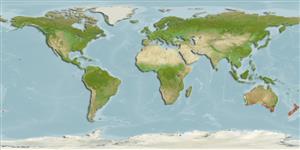Environment: milieu / climate zone / depth range / distribution range
экология
морской донно-пелагический; пределы глубины 0 - 33 m (Ref. 84085), usually 10 - ? m (Ref. 84085). Temperate
Southwest Pacific: Tasmania, Australia and New Zealand, including the Chatham Islands.
Size / Вес / Возраст
Maturity: Lm ? range ? - ? cm
Max length : 13.0 cm SL самец/пол неопределен; (Ref. 13227); наибольший возраст (опубликованны данные): 4 годы (Ref. 31614)
Краткое описание
определительные ключи | морфология | морфометрия
колючие лучи спинного плавника (общее число) : 26 - 32; членистые (мягкие) лучи спинного плавника (общее число) : 12 - 16. Head and pectoral fin base scaly (latter covered with cycloid scales), no scales on third dorsal fin membrane, ctenoid scales adjacent to but not overlapping base of third dorsal fin membrane. Lateral line scales short, posterior projection absent (present in specimens <88mm). Dorsal fin formula V-0N-0-1-0-1. Parhypural not fused. Nine procurrent rays in upper lobe, eight in lower lobe; in upper lobe, one procurrent ray opposite upper lobe, six opposite two epurals, two anterior to anterior epural; in lower lobe, one procurrent ray opposite lower lobe, six opposite haemal spine of second preural vertebra, one between haemal spine of second preural vertebra and haemal spine of third preural vertebra. Body with seven vertical bands of reddish-brown to black saddles (broad bands not extending onto ventral surface) (Ref. 84085).
Facultative air-breathing in the genus (Ref. 126274); Adults are generally more abundant above 10m, but common in areas of broken rock on reefs, rock pools and sub-tidally down to 33 m (Ref. 84085). They feed on benthic invertebrates. Spawning occurs from May to November (Ref. 9003). Eggs are hemispherical and covered with numerous sticky threads that anchor them in the algae on the nesting sites (Ref. 240). Larvae are planktonic which occur primarily in shallow, nearshore waters (Ref. 94114).
Life cycle and mating behavior
половая зрелость | размножение | нерест | икра | Fecundity | личинки
Paulin, C. and C. Roberts, 1992. The rockpool fishes of New Zealand (Te ika aaria o Aotearoa). Museum of New Zealand (Te Papa Tongarewa). 177 p. (Ref. 9003)
Статус Красного Списка МСОП (Ref. 130435: Version 2024-1)
Угроза для людей
Harmless
Использование человеком
дополнительная информация
инструменты
Специальные отчеты
Скачать в формате XML
ресурсы в Интернет
Estimates based on models
Preferred temperature (Ref.
123201): 10.6 - 20.3, mean 16.5 °C (based on 422 cells).
Phylogenetic diversity index (Ref.
82804): PD
50 = 0.5039 [Uniqueness, from 0.5 = low to 2.0 = high].
Bayesian length-weight: a=0.00759 (0.00414 - 0.01389), b=3.05 (2.89 - 3.21), in cm total length, based on LWR estimates for this species & (Sub)family-body (Ref.
93245).
Trophic level (Ref.
69278): 3.5 ±0.4 se; based on diet studies.
устойчивость к внешним воздействиям (Ref.
120179): средний (среднего размера), минимальное время удвоения популяции 1.4-4.4 года (Tmax=4; K=1.85).
Fishing Vulnerability (Ref.
59153): Low vulnerability (10 of 100).
Nutrients (Ref.
124155): Calcium = 106 [54, 255] mg/100g; Iron = 0.561 [0.275, 1.110] mg/100g; Protein = 17.5 [16.3, 18.7] %; Omega3 = 0.409 [0.166, 1.002] g/100g; Selenium = 16.2 [6.1, 44.7] μg/100g; VitaminA = 14.7 [2.9, 74.4] μg/100g; Zinc = 1.15 [0.70, 1.79] mg/100g (wet weight);
